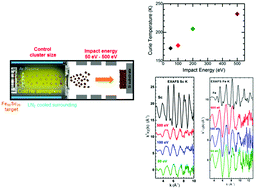Controlling the structure and magnetic properties of cluster-assembled metallic glasses†
Abstract
The potential to control the structure of amorphous materials and establish correlations with their properties would constitute an extraordinary step in formulating new pathways to design and tailor amorphous structures, which correspondingly would exhibit novel properties. Towards achieving this goal, a bottom-up approach is proposed here. In the present study, cluster-assembled Fe80Sc20 metallic glasses are used as the model systems to illustrate this potentially groundbreaking approach. Accordingly, Fe80Sc20 amorphous films are nanofabricated under well-defined conditions with precise control over cluster size and impact energy. Their local atomic structures are characterized by X-ray absorption spectroscopy around both constituent metals, i.e., Fe and Sc. The capability of controlling the local structure by controlling the deposition energy (i.e., the clusters’ impact energy) has resulted in substantial changes in the magnetic Curie temperature. In fact, the Curie temperature changes by as much as 60 K when the deposition energy is increased from 50 eV per cluster (the lowest deposition energy) to 500 eV per cluster (the highest deposition energy). This remarkable result, clearly establishing a structure–property relationship, observed for the first time in cluster-assembled metallic glasses, opens up new pathways for synthesizing novel amorphous materials with engineered structures and accompanying new properties.



 Please wait while we load your content...
Please wait while we load your content...